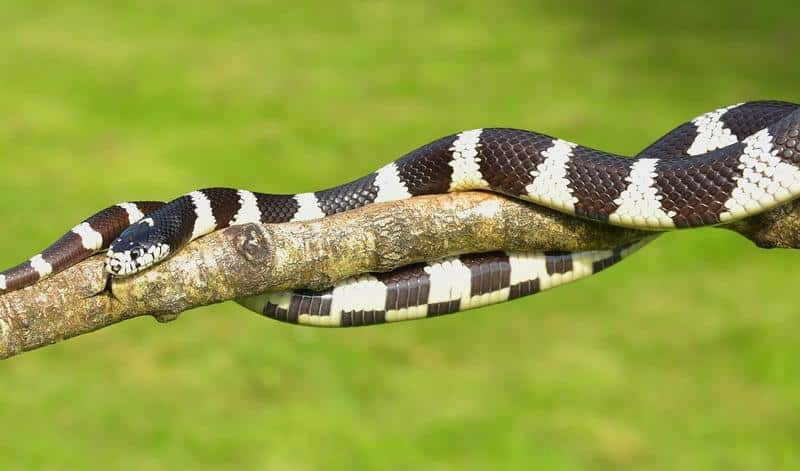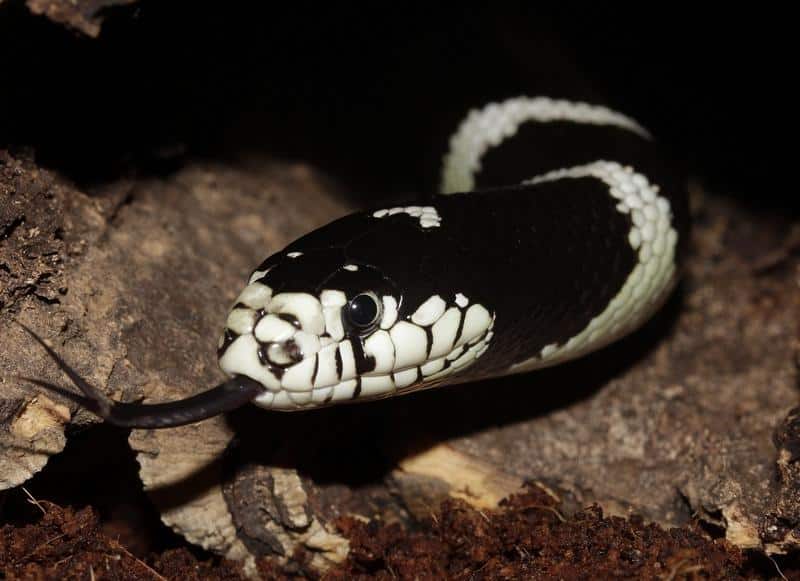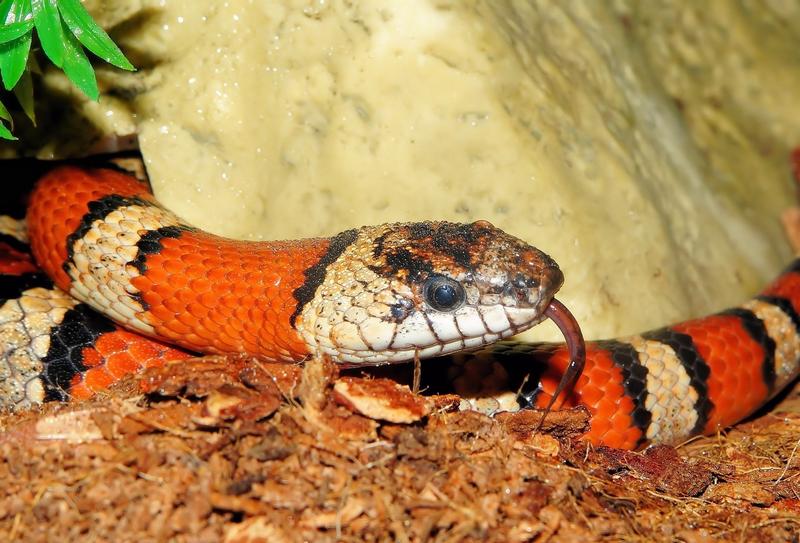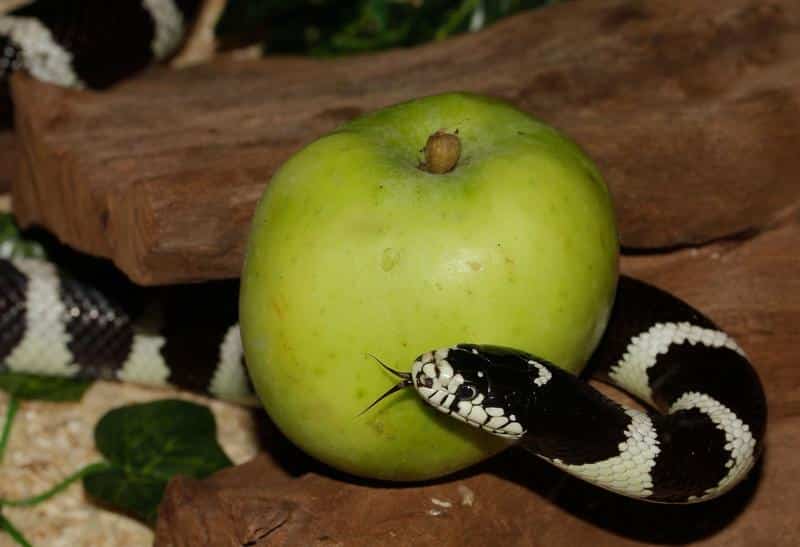Are King Snakes Poisonous to Dogs? Are King Snakes Dangerous to Dogs?
Are king snakes poisonous to dogs? Are king snakes dangerous to dogs? Today, we’ll answer both of these questions including what to do right away, and the command you’ll need to keep your dog safe during any future snake encounters.
After that, we’ll fill out your king snakes and dogs knowledge by informing you on things like do king snakes bite, what do king snakes look like, where do king snakes live, and more about their behavior and environment. Finally, we’ll finish by instructing you on how to get rid of king snakes safely. Keep reading!
Are King Snakes Poisonous to Dogs?

King snakes are not poisonous to dogs. These reptiles, part of the extensive family of non-venomous constrictor snakes, are generally considered safe in relation to dogs and humans. They are among many species of snakes that do not use venom to hunt or protect themselves.
Nevertheless, it’s worth noting that any snake, even those that are non-venomous like king snakes, can still bite, and such bites can potentially lead to infection or trigger an allergic reaction. Therefore, while king snakes aren’t poisonous, you should still discourage and prevent your pup from engaging in any form of interaction with them.
Are King Snakes Venomous?
King snakes are not venomous. Native to various regions in the Americas, they are constrictor snakes, which means they rely on their muscular bodies to coil around and squeeze their prey rather than using venom to immobilize them.
A bite from a king snake might cause some discomfort, but it won’t introduce venom into the wound. King snakes are remarkably effective predators, so much so that they are known to consume other snakes, even those that are venomous.
This unique dietary preference is part of what has earned them their regal name, “king” snakes, as they are regarded as ‘kings’ amongst other snake species due to their capability to eat venomous snakes with immunity to their venom.
King Snakes and Dogs
King snakes are not dangerous to dogs inherently. Generally, these snakes are docile and will avoid conflict with larger animals, such as dogs. However, like all animals, they may bite when they feel threatened.
While a bite from a king snake is not venomous, it could cause infection or an allergic reaction. Therefore, it’s important to supervise your dog when in areas where king snakes may be present and discourage any potential interactions.
Train the “Leave It” Command
To help safeguard your dog from potentially harmful interactions with a king snake or any other potential threats, teaching your dog the “Leave It” command can be beneficial. Here’s a brief guide to get you started:
- Begin by holding a treat in a closed fist, showing it to your dog without allowing them to have it.
- When your dog stops trying to get the treat and withdraws, say “Leave it” and give them a different treat from your other hand.
- Repeat this exercise several times, always saying “Leave it” as your dog pulls away and rewarding them with a different treat.
- Practice in various situations and with different items, gradually increasing the challenge until your dog reliably responds to the command.
These steps will get your dog to stay away from king snakes, but it’s important to remember that the underlying behavioral issues (prey drive, aggression, dominance, etc.) that were causing all of this to begin with will still be present. And until you address those, any positive changes you see are only going to be temporary.
“Well, how do I make these changes last?”
By getting your dog to truly choose to follow your direction, that’s how. I tried many times to write out how you can do that before deciding it made more sense to just link you to the free video series that explains it better than I’d ever be able to.
The series is by a man named Dan who is one of the world’s leading dog obedience trainers. In it, he teaches you how to put an end to things like when your dog bothers king snakes and all other misbehavior using his fast and easy-to-follow methods.
In the first video, Dan will reveal to you why the two most common methods of dog training only doom you to failure. You can watch the video now by clicking here. Follow the proven system he’ll show you in his series and you’ll never have to spend another second worrying about your dog chasing king snakes ever again!
Are King Snakes Dangerous to Dogs?

King snakes are not dangerous to dogs. These non-venomous constrictor snakes are generally harmless to larger animals, including our canine companions. However, like all animals, they can bite if threatened or cornered. While a bite from a king snake is not venomous, it could cause discomfort, potential infection, or even trigger an allergic reaction.
King Snake Bite Dog
While king snakes are not venomous, a bite from a king snake can still potentially harm a dog. Even though the bite does not contain venom, it can be painful and can result in redness, swelling, and possible infection.
If a king snake bites your dog, you need to clean the wound thoroughly and keep an eye out for any signs of infection, such as increasing swelling or redness, pus, or changes in your dog’s behavior. Consulting with a vet is also recommended in case of a snakebite, even if the snake is known to be non-venomous.
Learn the command you’ll need to keep your dog safe in future encounters by going back to the first section.
Will a King Snake Bite a Dog?
King snakes are not usually aggressive, and they typically avoid interaction with larger animals, such as dogs. However, if a king snake feels cornered or threatened, it may bite as a defense mechanism. Therefore, it’s best to prevent dogs from investigating or pestering snakes to avoid any potential bites.
Are King Snakes Aggressive?
King snakes are not aggressive towards humans or larger animals generally. They are more likely to flee from potential danger than engage. However, like any animal, they can display defensive behaviors when they feel threatened. A king snake might coil its body, hiss, or even strike if it feels it has no other option. As always, it’s best to respect all wildlife and maintain a safe distance.
You should get this taken care of now as it will make your dog safe during potential interactions with other snakes and critters as well.
You will then never have to ask yourself questions like are milk snakes poisonous to dogs, are corn snakes poisonous to dogs, what to do about copperhead dog bites, are rat snakes poisonous to dogs, what to do about black rat snake dog bites, or are garter snakes poisonous to dogs because you’ll know your pup will behave.
What Do King Snakes Look Like?

King snakes are medium to large in size and are known for their vibrant patterns. They have smooth, shiny scales and their bodies display bands, rings, or longitudinal stripes in colors like red, black, yellow, and white. These colors and patterns, however, can greatly vary depending on their specific subspecies and geographical location.
What Color is a King Snake?
The color of a king snake can vary greatly. They often exhibit banding or other distinct patterns, with color combinations such as red, white, and black or yellow, black, and white. The specific color and pattern arrangement can depend on the subspecies and their geographical location.
Where Do King Snakes Live?
King snakes are found in a variety of habitats across North America. They can inhabit forests, grasslands, and desert areas, and are also commonly found near farmland or in suburban areas. These snakes are adaptive and resilient, capable of surviving in different environments.
King Snake vs Coral Snake
King snakes and coral snakes can have very similar color patterns, which can lead to confusion. A useful rhyme, “red on black, friend of Jack; red on yellow, kill a fellow,” can help differentiate the two. This refers to the color band sequence. In most king snakes with tri-color patterns, the red bands are bordered by black, while in coral snakes, the red bands are bordered by yellow.
Where Are King Snakes Found?
King snakes are found across North America, from the east coast to the west, and from southern Canada to northern South America. There are various subspecies of king snakes, and each tends to have a preferred habitat and geographic range.
When Are King Snakes Most Active?
King snakes are primarily diurnal, meaning they are most active during the day. However, in hot weather, they may shift to being more active at dawn and dusk to avoid extreme temperatures. Like many reptiles, king snakes will brumate (a form of hibernation) during colder months.
Learn the command that will keep your dog safe during an encounter with a king snake by going back to the first section now.
How to Get Rid of King Snakes

To get rid of king snakes, it’s important to make your property less appealing to them by managing food sources, reducing hiding places, and blocking access to your home. Remember, king snakes are non-venomous and can help control other pests, so a peaceful coexistence is often the best approach.
- Manage Food Sources: King snakes primarily feed on rodents and other small animals, so controlling these populations in your yard and home will make your property less attractive to them. This can be done through trapping, using natural predators, or even professional pest control services.
- Reduce Hiding Places: King snakes prefer to hide in places like woodpiles, rock piles, and thick vegetation. By keeping your yard clean and tidy, and removing such potential hiding spots, you can discourage them from residing in your area.
- Block Access to Your Home: Make sure to seal any potential entry points into your home, particularly at ground level, to prevent king snakes from finding a way inside. This includes cracks, gaps, and holes in the walls or foundation of your home.
- Consider Professional Help: If the king snake population becomes too large or if you’re uncomfortable handling these creatures, consider hiring a professional wildlife removal service. They are experienced in dealing with snakes and can safely and humanely relocate them.
Getting rid of king snakes revolves around making your property less appealing to them. By managing their food sources, reducing their potential hiding places, and ensuring your home is sealed off, you can deter king snakes. But remember, they can be helpful in controlling other pests, so coexistence is often the best approach.
Learn to control your dog’s behavior around king snakes and other reptiles by going back to the first section.
I’m sure you’re ready to not worry about this problem anymore, so I’ll let you get started on things now. Good luck with all of this, and thanks for reading our article “Are King Snakes Poisonous to Dogs? Are King Snakes Dangerous to Dogs?”





